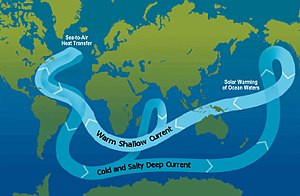Climate variability includes all the variations in the climate that last longer than individual weather events, whereas the term climate change only refers to those variations that persist for a longer period of time, typically decades or more.
In the time since the industrial revolution the climate has increasingly been affected by human activities that are causing global warming and climate change.
Ex.. of climate change and variability ::-
- include changes in solar output and volcanism.
Ocean-atmosphere variability

Oscillations and cycles ::-
A climate oscillation or climate cycle is any recurring cyclical oscillation within global or regional climate.
- the El Niño Southern Oscillation (ENSO) – A large scale pattern of warmer (El Niño) and colder (La Niña) tropical sea surface temperatures in the Pacific Ocean with worldwide effects.
- the Madden–Julian oscillation (MJO) - An eastward moving pattern of increased rainfall over the tropics with a period of 30 to 60 days, observed mainly over the Indian and Pacific Oceans.
- the North Atlantic Oscillation (NAO) – Indices of the NAO are based on the difference of normalized sea level pressure(SLP) between Ponta Delgada, Azores and Stykkisholmur/Reykjavik, Iceland.
- the El Niño Southern Oscillation (ENSO) – A large scale pattern of warmer (El Niño) and colder (La Niña) tropical sea surface temperatures in the Pacific Ocean with worldwide effects.
- the Madden–Julian oscillation (MJO) - An eastward moving pattern of increased rainfall over the tropics with a period of 30 to 60 days, observed mainly over the Indian and Pacific Oceans.
- the North Atlantic Oscillation (NAO) – Indices of the NAO are based on the difference of normalized sea level pressure(SLP) between Ponta Delgada, Azores and Stykkisholmur/Reykjavik, Iceland.
Ocean current changes
 A schematic of modern thermohaline circulation. Tens of millions of years ago, continental-plate movement formed a land-free gap around Antarctica, allowing the formation of the ACC, which keeps warm waters away from Antarctica.
A schematic of modern thermohaline circulation. Tens of millions of years ago, continental-plate movement formed a land-free gap around Antarctica, allowing the formation of the ACC, which keeps warm waters away from Antarctica.
The oceanic aspects of climate variability can generate variability on centennial timescales due to the ocean having hundreds of times more mass than in the atmosphere, and thus very high thermal inertia
Example ::-
alterations to ocean processes such as thermohaline circulation play a key role in redistributing heat in the world's oceans.
 A schematic of modern thermohaline circulation. Tens of millions of years ago, continental-plate movement formed a land-free gap around Antarctica, allowing the formation of the ACC, which keeps warm waters away from Antarctica.
A schematic of modern thermohaline circulation. Tens of millions of years ago, continental-plate movement formed a land-free gap around Antarctica, allowing the formation of the ACC, which keeps warm waters away from Antarctica.The oceanic aspects of climate variability can generate variability on centennial timescales due to the ocean having hundreds of times more mass than in the atmosphere, and thus very high thermal inertia
Example ::-



Suppppbbbbbbbbb
ReplyDelete